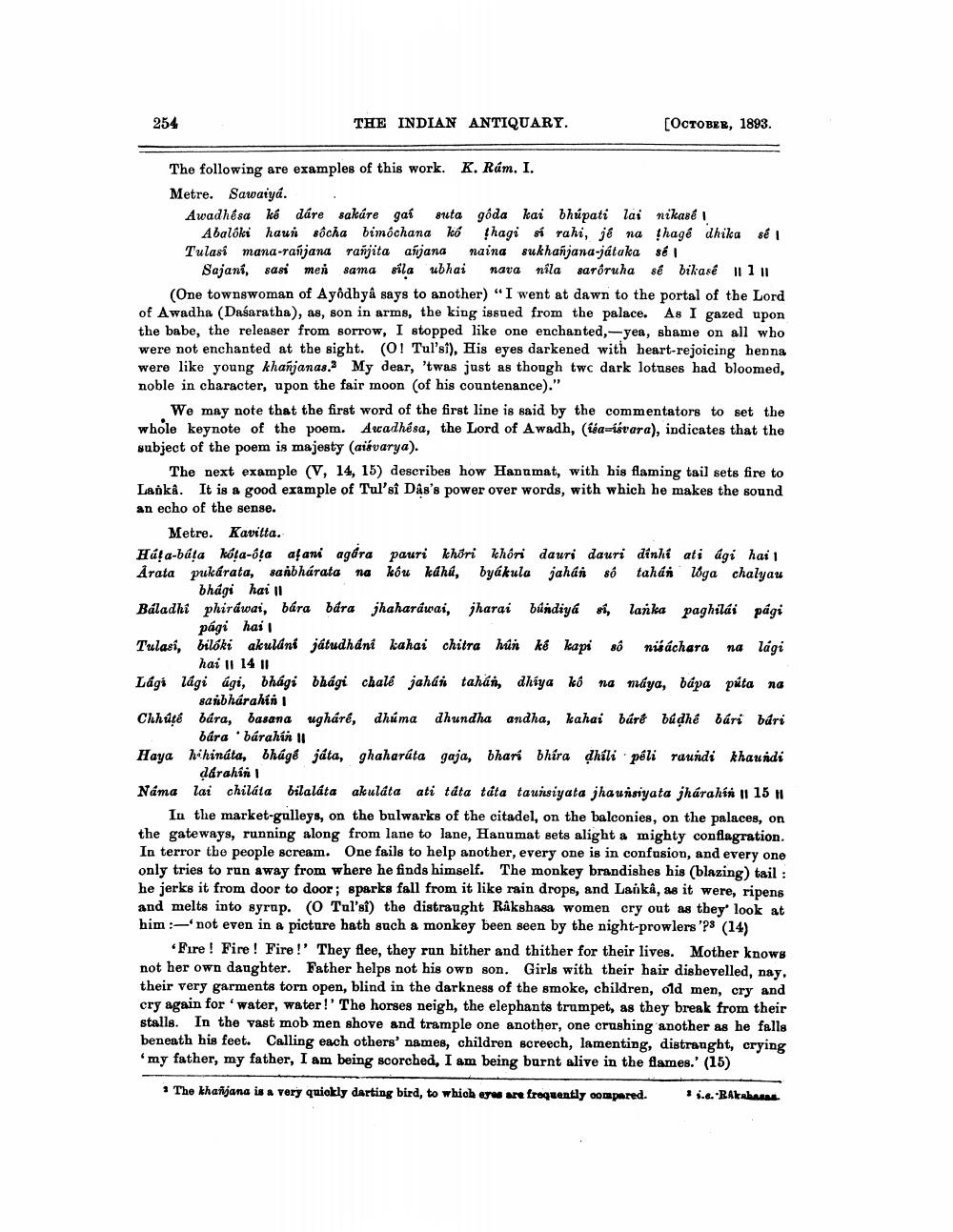________________
254
THE INDIAN ANTIQUARY.
[OCTOBER, 1893.
The following are examples of this work. K. Rám. I. Metre. Sawaiya. Awadhésa ké dáre sakáre gai euta goda kai bhúpati lai nikase!
Abalóki haun sôcha bimochana kó hagi si rahi, je na thagé dhika sé Tulasi mana-ranjana ranjita asjana naina sukhanjana-játaka sé
Sajani, sasi men sama sila ubhai nava nila sarőruha sé bikasé 1111 (One towngwoman of Ayodhyâ says to another) "I went at dawn to the portal of the Lord of Awadha (Dasaratha), as, son in arms, the king issued from the palace. As I gazed upon the babe, the releaser from sorrow, I stopped like one enchanted, -yea, shame on all who were not enchanted at the sight. (O! Tul'si), His eyes darkened with heart-rejoicing henna were like young khanjanas. My dear, 'twas just as though twc dark lotuses had bloomed, noble in character, upon the fair moon (of his countenance)."
We may note that the first word of the first line is said by the commentators to set the whole keynote of the poem. Aradhésa, the Lord of Awadh, isa-isvara), indicates that the subject of the poem is majesty (aišvarya).
The next example (V, 14, 15) describes how Hanomat, with his flaming tail sets fire to Laoka. It is a good example of Tulsi Das's power over words, with which he makes the sound an echo of the sense.
Metre. Kavitta. Háta-báta kóta-óta afani agára pauri khöri khóri dauri dauri dinhi ati dgi hai Arata pukárata, sanbhárata na kou káhí, byákula jahan 80 tahán lóga chalyau
bhagi hai | Baladht phirdwai, bára bára jhahardwai, jharai bindiya si, lanka paghildi pagi
pági hai Tulasi, bilóki akuláni játudhani kahai chitra hún ké kapi 86 nisáchara na lági
hai II 14 III Lági lági ági, bhági bhági chalé jahái tahár, dhiya ko na máya, bápa púta na
sanbhárahis Chhúţé bára, basana ugharé, dhuma dhundha andha, kahai báré budhé bári bári
bára bárahin II Haya hihináta, thágê játa, ghaharūta gaja, bhari bhíra dhili péli raundi khaundi
darahin Náma lai chiláta bilaláta akuláta ati táta táta tausiyata jhaunsiyata jhárahis 11 15 H
In the market-gulleys, on the bulwarks of the citadel, on the balconies, on the palaces, on the gateways, running along from lane to lane, Hanumat sets alight a mighty conflagration. In terror the people scream. One fails to help another, every one is in confusion, and every one only tries to run away from where he finds himself. The monkey brandishes his (blazing) tail: he jerks it from door to door; sparks fall from it like rain drops, and Lanka, as it were, ripens and melts into syrap. (O Tul'sî) the distraught Rakshasa women cry out as they look at him not even in a picture hath such a monkey been seen by the night-prowlers '? (14)
Fire! Fire! Fire!' They flee, they run bither and thither for their lives. Mother knows not her own daughter. Father helps not his own son. Girls with their hair dishevelled, nay, their very garments torn open, blind in the darkness of the smoke, children, old men, cry and cry again for 'water, water!' The horses neigh, the elephants trumpet, as they break from their stalls. In the vast mob men shove and trample one another, one crushing another as he falls beneath his feet. Calling each others' names, children screech, lamenting, distraught, crying 'my father, my father, I am being scorched, I am being burnt alive in the flames.' (15)
1 The khafijana is a very quickly darting bird, to which we are frequently compared. .."Rakabase




